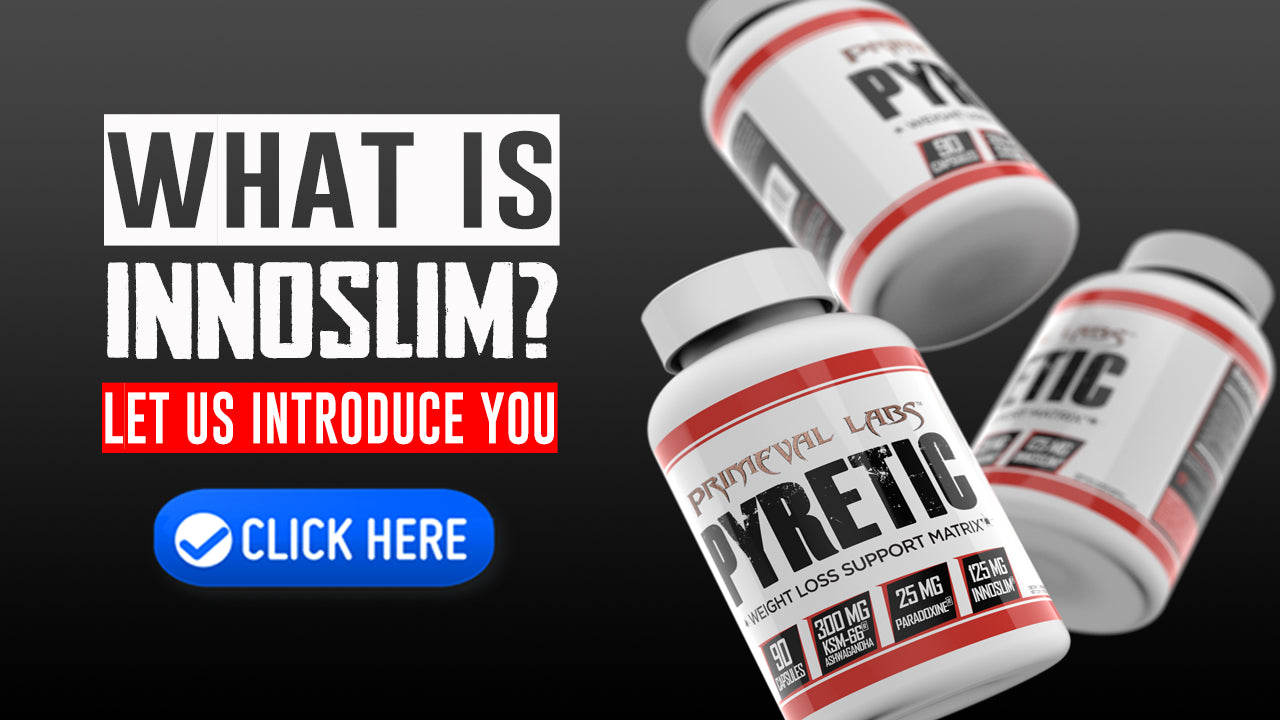Today, we take a deep dive into one of the hottest new weight loss support supplements in InnoSlim -- an all-natural plant extract documented to promote weight loss, reduce appetite, and improve fat breakdown.

Looking for Help?
Pyretic is a stimulant-free thermogenic weight loss support matrix scientifically-formulated to help reduce appetite and boost thermogenesis.
Before we get too far into the benefits of InnoSlim, let’s discuss precisely what it is.
What is InnoSlim?
InnoSlim® is an all-natural ingredient derived from Panax Notoginseng and Astragalus that supports long-term weight loss. It was developed by NuLiv Science and has been shown in clinical trials to:
- enhance fat burning
- reduce appetite
- Decrease glucose absorption in the gut
- improve glucose absorption by skeletal muscle
- encourage fatty acid breakdown in adipose tissue (fat cells)
What Does InnoSlim Do?
Increased Energy Expenditure (Calories Burned)
To understand how InnoSlim helps increase the number of calories you can burn, we need to discuss a few big-time hormones and enzymes that play a key role in cellular energy homeostasis.
Leading the charge is adiponectin -- a hormone that is secreted by fat cells that has been identified as a key regulator of insulin sensitivity and inflammation.[2,3]
Adiponectin has a wide range of activities across a number of tissues, including the liver, skeletal muscle and the vasculature where it helps improve insulin sensitivity, boost fuel burning (via up-regulation of AMPK activity) and reduce vascular inflammation.[3]
Adiponectin can also attenuate the buildup of triglycerides in skeletal muscle tissue.
Due to its insulin-sensitizing, anti-diabetic, anti-inflammatory, and anti-atherogenic effects, adiponectin has been spotlighted as a target for certain chronic diseases, including diabetes and metabolic syndrome.
However, as body fat increases, adiponectin secretion and concentration in the blood decreases.[2,3] This reduction plays a critical role in several obesity-related diseases.
InnoSlim has been shown to increase adiponectin secretion from fat cells up to 103%.[1] Additionally, InnoSlim has also been noted to decrease the inflammatory biomarkers PAI-1, RBP4, and TNF-α which can hamper optimal secretion of adiponectin.[1]
Increased secretion of the hormone led to greater glucose utilization in skeletal muscle as well as increased fatty acid oxidation in muscle and liver.[1]
As a result of increased adiponectin release, AMPK activity is up-regulated in skeletal muscle (up to 23%).
Why is this important?
AMPK (AMP-activated protein kinase) is an enzyme found in every single cell of our body, where it serves as a “master regulator” switch for energy production. It also plays a critical role in regulating growth.[4]
AMPK is activated by various stressors that increase the ratio of AMP (adenosine monophosphate) to ATP (the cellular currency of energy production), such as exercise (which uses ATP to power muscle contractions), glucose deprivation (i.e. fasting), or hypoxia.[6]
As a result of increasing AMP concentrations, AMPK initiates a cascade of processes that increase ATP generation, including glucose transport and fatty acid oxidation (fat burning).[6]
AMPK activation also tends to limit ATP-consuming processes including cell growth and protein synthesis (which is why it’s generally a good idea to avoid AMPK-activated compounds around the workout window...you don’t want to hamper muscle growth or recovery).
However, like most things...as we age AMPK activation decreases, which puts a crimp in our ability to efficiently burn fat.
Research indicates that InnoSlim may help reverse this drop in AMPK activity.[1]
More importantly, for those seeking weight loss support, increased AMPK activity promotes fat burning in the liver and skeletal muscle tissue while also helping blunt synthesis of cholesterol, fat, and triglycerides.[1,7]
AMPK activation also leads to activation of GLUT4, the main insulin-regulated glucose transporter for skeletal muscles and fat tissue.[5] Increased GLUT4 activity leads to greater glucose uptake by skeletal muscles, thereby lowering blood sugar levels.[1]
Furthermore, greater GLUT4 activity also increases phospho-ACC, which inhibits fatty acid formation.
Due to the various metabolic machinations induced by InnoSlim, in vitro studies have found that InnoSlim increases glucose utilization in muscle and fat cells.[1]
The result of this cascade of effects leads to increased calorie expenditure, which supports weight loss.
But that’s not all InnoSlim is capable of...it may also
Decrease Energy Intake (Calories Ingested)
Not only has InnoSlim been noted to help increase energy expenditure, but it’s also been noted to help reduce energy intake.
This occurs as a result of downregulation of the SGLT1 protein and mRNA expression levels in the intestine.[1]
SGLT1 stands for sodium-dependent glucose transporter-1, and it mediates glucose absorption in the intestines.[8,9]
Less SGLT1 means less glucose is absorbed in the gut, which subsequently reduces energy intake.[1] Another added benefit of decreased glucose uptake is lower blood glucose levels.[9]
InnoSlim also contributes to decreased energy intake by reducing appetite via decreasing glucose levels in the bloodstream and increasing insulin activity.[1]
What are the Research-Backed Benefits of InnoSlim?
- Decreases glucose absorption up to 42% (using CaCO 2 cells)[1]
- Reduces calorie intake via downregulation of SGLT1[1]
- Increases glucose uptake in skeletal muscle cells[1]
- Increasing fatty acid breakdown in fat cells[1]
- Increases AMPK activation in skeletal muscle by 23%[1]
- Decreases markers of inflammation and insulin resistance[1]
What Supplements Contain InnoSlim?
Primeval Labs Pyretic supplies 125mg InnoSlim in each serving.
Pyretic is a stimulant-free thermogenic weight loss support matrix scientifically formulated to help reduce appetite, boost thermogenesis, and enhance calorie burning.
Pyretic is 100% natural, non-hormonal and will not cause any jitters.
Research
- InnoSlim Product Dossier
- Achari AE, Jain SK. Adiponectin, a Therapeutic Target for Obesity, Diabetes, and Endothelial Dysfunction. Int J Mol Sci. 2017;18(6):1321. Published 2017 Jun 21. doi:10.3390/ijms18061321
- Whitehead, J. P., Richards, A. A., Hickman, I. J., Macdonald, G. A., & Prins, J. B. (2006). Adiponectin--a key adipokine in the metabolic syndrome. Diabetes, Obesity & Metabolism, 8(3), 264–280. https://doi.org/10.1111/j.1463-1326.2005.00510.x
- Mihaylova MM, Shaw RJ. The AMPK signalling pathway coordinates cell growth, autophagy and metabolism. Nat Cell Biol. 2011;13(9):1016–1023. Published 2011 Sep 2. doi:10.1038/ncb2329
- Huang, S., & Czech, M. P. (2007). The GLUT4 glucose transporter. Cell Metabolism, 5(4), 237–252. https://doi.org/10.1016/j.cmet.2007.03.006
- Richter, Erik A., and Neil B. Ruderman. "AMPK and the biochemistry of exercise: implications for human health and disease." Biochemical Journal, vol. 418, no. 2, 2009, pp. 261-275.
- Jeon SM. Regulation and function of AMPK in physiology and diseases. Exp Mol Med. 2016;48(7):e245. Published 2016 Jul 15. doi:10.1038/emm.2016.81
- Du, F., Hinke, S. A., Cavanaugh, C., Polidori, D., Wallace, N., Kirchner, T., … Hornby, P. J. (2018). Potent Sodium/Glucose Cotransporter SGLT1/2 Dual Inhibition Improves Glycemic Control Without Marked Gastrointestinal Adaptation or Colonic Microbiota Changes in Rodents. Journal of Pharmacology and Experimental Therapeutics, 365(3), 676 LP – 687. https://doi.org/10.1124/jpet.118.248575
- Röder PV, Geillinger KE, Zietek TS, Thorens B, Koepsell H, Daniel H. The role of SGLT1 and GLUT2 in intestinal glucose transport and sensing. PLoS One. 2014;9(2):e89977. Published 2014 Feb 26. doi:10.1371/journal.pone.0089977









Leave a comment
This site is protected by hCaptcha and the hCaptcha Privacy Policy and Terms of Service apply.